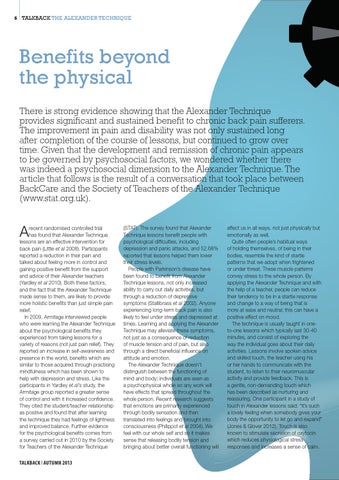6 Talkback the alexander technique
Benefits beyond the physical There is strong evidence showing that the Alexander Technique provides significant and sustained benefit to chronic back pain sufferers. The improvement in pain and disability was not only sustained long after completion of the course of lessons, but continued to grow over time. Given that the development and remission of chronic pain appears to be governed by psychosocial factors, we wondered whether there was indeed a psychosocial dimension to the Alexander Technique. The article that follows is the result of a conversation that took place between BackCare and the Society of Teachers of the Alexander Technique (www.stat.org.uk).
A
recent randomised controlled trial has found that Alexander Technique lessons are an effective intervention for back pain (Little et al 2008). Participants reported a reduction in their pain and talked about feeling more in control and gaining positive benefit from the support and advice of their Alexander teachers (Yardley et al 2010). Both these factors, and the fact that the Alexander Technique made sense to them, are likely to provide more holistic benefits than just simple pain relief. In 2009, Armitage interviewed people who were learning the Alexander Technique about the psychological benefits they experienced from taking lessons for a variety of reasons (not just pain relief). They reported an increase in self-awareness and presence in the world, benefits which are similar to those acquired through practising mindfulness which has been shown to help with depression and stress. Like the participants in Yardley et al’s study, the Armitage group reported a greater sense of control and with it increased confidence. They cited the student/teacher relationship as positive and found that after learning the technique they had feelings of lightness and improved balance. Further evidence for the psychological benefits comes from a survey carried out in 2010 by the Society for Teachers of the Alexander Technique
Talkback l autumn 2013
(STAT). The survey found that Alexander Technique lessons benefit people with psychological difficulties, including depression and panic attacks, and 52.68% reported that lessons helped them lower their stress levels. People with Parkinson’s disease have been found to benefit from Alexander Technique lessons, not only increased ability to carry out daily activities, but through a reduction of depressive symptoms (Stallibrass et al 2002). Anyone experiencing long-term back pain is also likely to feel under stress and depressed at times. Learning and applying the Alexander Technique may alleviate these symptoms, not just as a consequence of reduction of muscle tension and of pain, but also through a direct beneficial influence on attitude and emotion. The Alexander Technique doesn’t distinguish between the functioning of mind and body; individuals are seen as a psychophysical whole so any work will have effects that spread throughout the whole person. Recent research suggests that emotions are primarily experienced through bodily sensation and then translated into feelings and brought into consciousness (Philippot et al 2004). We feel with our whole self and so it makes sense that releasing bodily tension and bringing about better overall functioning will
affect us in all ways, not just physically but emotionally as well. Quite often people’s habitual ways of holding themselves, of being in their bodies, resemble the kind of startle patterns that we adopt when frightened or under threat. These muscle patterns convey stress to the whole person. By applying the Alexander Technique and with the help of a teacher, people can reduce their tendency to be in a startle response and change to a way of being that is more at ease and neutral; this can have a positive effect on mood. The technique is usually taught in oneto-one lessons which typically last 30-40 minutes, and consist of exploring the way the individual goes about their daily activities. Lessons involve spoken advice and skilled touch, the teacher using his or her hands to communicate with the student, to listen to their neuromuscular activity and provide feedback. This is a gentle, non-demanding touch which has been described as nurturing and reassuring. One participant in a study of touch in Alexander lessons said: “It’s such a lovely feeling when somebody gives your body the opportunity to let go and expand” (Jones & Glover 2012). Touch is also known to stimulate secretion of oxytocin which reduces physiological stress responses and increases a sense of calm.
